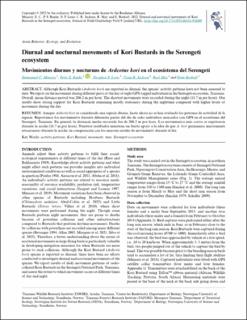| dc.contributor.author | Mmassy, Emmanuel Clamsen | |
| dc.contributor.author | Ranke, Peter S. | |
| dc.contributor.author | Lesio, Nicephor | |
| dc.contributor.author | Jackson, Craig Ryan | |
| dc.contributor.author | May, Roelof Frans | |
| dc.contributor.author | Røskaft, Eivin | |
| dc.date.accessioned | 2023-03-09T12:19:06Z | |
| dc.date.available | 2023-03-09T12:19:06Z | |
| dc.date.created | 2022-12-07T12:39:05Z | |
| dc.date.issued | 2022 | |
| dc.identifier.issn | 0273-8570 | |
| dc.identifier.uri | https://hdl.handle.net/11250/3057360 | |
| dc.description.abstract | Although Kori Bustards (Ardeotis kori) are reported as diurnal, the species’ activity patterns have not been assessed to date. We report on the movement during different parts of the day of eight GPS-tagged individuals in the Serengeti ecosystem, Tanzania. Overall, mean distance moved was 206.2 m per hour. The shortest movements were recorded during the night (18.7 m per hour). Our results show strong support for Kori Bustards remaining mostly stationary during the nighttime compared with higher levels of movement during the day. | en_US |
| dc.language.iso | eng | en_US |
| dc.publisher | Wiley | en_US |
| dc.rights | Navngivelse 4.0 Internasjonal | * |
| dc.rights.uri | http://creativecommons.org/licenses/by/4.0/deed.no | * |
| dc.title | Diurnal and nocturnal movements of Kori Bustards in the Serengeti ecosystem | en_US |
| dc.title.alternative | Movimientos diurnos y nocturnos de Ardeotus kori en el ecosistema del Serengeti | en_US |
| dc.title.alternative | Diurnal and nocturnal movements of Kori Bustards in the Serengeti ecosystem | en_US |
| dc.type | Peer reviewed | en_US |
| dc.type | Journal article | en_US |
| dc.description.version | publishedVersion | en_US |
| dc.source.volume | 93 | en_US |
| dc.source.journal | Journal of field ornithology | en_US |
| dc.source.issue | 4 | en_US |
| dc.identifier.doi | 10.5751/JFO-00188-930409 | |
| dc.identifier.cristin | 2090052 | |
| cristin.ispublished | true | |
| cristin.fulltext | original | |
| cristin.qualitycode | 1 | |

